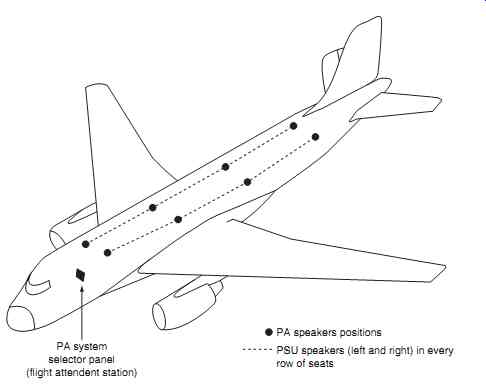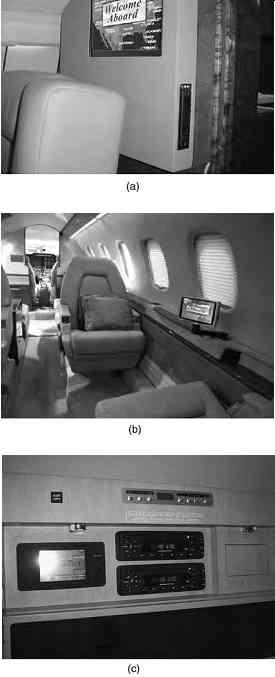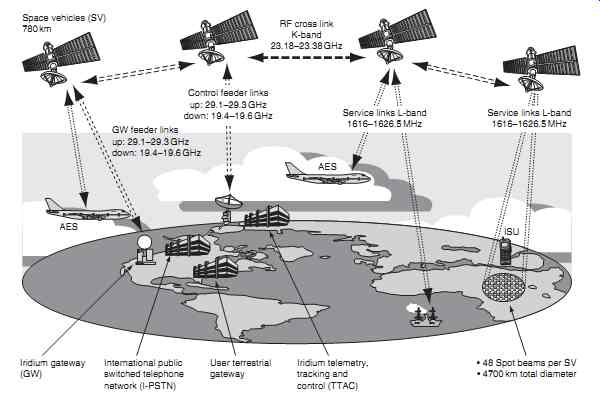AMAZON multi-meters discounts AMAZON oscilloscope discounts
Passenger transport and business aircraft are fitted with a range of cabin electronic equipment for passenger safety, convenience and entertainment. Typical applications for this equipment include lighting, audio and visual systems. Cabin lighting is used for the safety and comfort of passengers; this was described in Section 12. Audio systems include the passenger address system used by the flight or cabin crew to give out safety announcements and other flight information. These announcements are made from hand held microphones and are heard over loudspeakers in the cabin and passenger headsets. The same system can be used to play automatic sound tracks; this is often used for announcements in foreign languages, or to play background music during boarding and disembarkation. Audio systems are also available at the individual seat positions.
A range of galley equipment is installed on business and passenger aircraft. The nature of this equipment depends on the size and role of the aircraft. Air conditioning is provided in passenger aircraft for the comfort of passenger; pressurization is required for flying at high altitudes. Both these systems have electrical and electronic interfaces and control functions.
Airstairs allow passengers, flight crew and ground personnel to board or depart the aircraft without the need for a mobile staircase or access to a terminal.
This section describes the many types of systems and equipment used for passenger safety, convenience and entertainment.
==========

FIG. 1 Public address (PA) system overview
PA system selector panel (flight attendant station); PA speakers positions; PSU speakers (left and right) in every row of seats
==========

FIG. 2 Public address (PA) selector panel
Announcement selection controls; Power ON/OFF; Boarding music channel select; Boarding music on/off volume control
========
1. Passenger address system
The passenger address (PA) system is primarily a safety system that provides passengers with voice announcements and chime signals from the flight or cabin crew; its secondary purpose is for the audio entertainment system. The crew make these voice announcements via the interphone system (see Aircraft Communication and Navigation Systems, a related book in the series). The PA amplifier provides a level of sidetone to the crew's handset or headsets during voice announcements. Sidetone is the technique of feeding back a small amount of sound from the mouthpiece and introducing this at low level back into the earpiece of the same handset, acting as feedback to confirm that the handset or headsets are functional.
The PA system audio outputs are transmitted through to speakers located in the cabin, see FIG. 1; typical locations include:
-- passenger service units (PSUs)
-- galleys
-- washrooms
-- cabin crew areas
PA voice announcements are integrated with the passenger entertainment system so that safety announcements can be made over and above entertainment channels.
A typical PA system is controlled by a selector panel (FIG. 2) located at cabin crew stations; an amplifier makes chime sounds in response to discrete signals from the cabin interphone system; examples of these chimes include:
-- a single low chime to indicate when the ' no smoking ' and ' fasten seat belt ' lights have been switched on
-- a single high/low chime for calls between cabin crew stations
-- three high/low chimes when the flight crew needs to gain the attention of the cabin crew
-- a single high chime when a passenger needs to gain the attention of the cabin crew
Test your understanding
What is the primary purpose of a cabin PA system?
PA systems are often integrated with video systems used for giving cabin safety information to passengers. A complete cabin management system includes:
-- crew announcements
--recorded announcements
-- video system audio
-- boarding music
-- chimes
2. Galley equipment
Galley equipment is a major consideration for the design of an aircraft's electrical power system since it can represent a high proportion of the total load requirements. The nature of the installed equipment depends on the size and role of aircraft, e.g. if it is operating short or long routes, the type of cabin classification (economy, business first class etc). In the 1930s, the Douglas Aircraft DC-3 was the first air craft to have a purpose-built area galley area for the preparation of food and beverages. Typical galley equipment on a modern aircraft now includes:
-- beverage makers
-- ovens/cookers
-- refrigeration units
Typical power requirements for galley equipment on a typical narrow body aircraft are given in Table 1.
Power from the main distribution system is sup plied to a dedicated galley bus which also contains its own protection circuits; galley power is the first non essential load to be shed.
3. In-flight entertainment (IFE)
This was initially introduced onto aircraft to break the boredom of long flight times; IFE is now part of an airline's image and forms part of its competitive edge.
There is now a vast range of cabin electronic equipment that is used for passenger safety, convenience and entertainment.
=======

Table 1 Typical power requirements for galley equipment on a typical narrow
body aircraft
Product; QPA; Power supply; Rating; Protection
Beverage maker: 10 200 VAC three-phase 400 Hz 2750 W 7A
Ovens: 5 200 VAC three-phase 400 Hz 1000 W 5A
Refrigeration units: 5 200 VAC three-phase 400 Hz 1000 W 5A
========
3.1 Overview
The first ever in-flight ' movie ' was shown in 1925.
These early systems were traditional projectors and screens. This was followed in the 1960s by centralized television screens placed at the front of each cabin. This concept was further developed into video projectors suspended on the aircraft ceiling and large screens on the bulkheads. Smaller business aircraft are installed with video screens fitted into the front and/or rear bulkheads; larger aircraft are installed with monitors integrated within the overhead panels or, more usually, into the back of the seat headrest.
Satellite-based communication is available with an individual transmitter/receiver and handset for business aircraft through to multiple access systems on larger passenger aircraft. The rapid development of broadband communications and satellite systems has also facilitated access to the Internet via laptop computers at an individual seat position. The use of mobile phones is not permitted by many regulatory authorities due to the potential interference with air craft systems; technology is being developed to allow their use on aircraft.
Audio entertainment systems installed on aircraft range from a single source, e.g. a digital versatile disc (DVD) player on private aircraft through to multi channel systems with multiple channels on larger air craft. Passengers are able to select from a wide range of music channels, news bulletins, current affairs, documentaries and comedy channels etc. Audio channels are played through headphones that plug into an individual seat position. Video entertainment is traditionally provided via a large video screen at the front of each cabin zone, together with smaller monitors suspended from the ceiling situated every few rows. Audio is supplied via the same headphones used for audio entertainment. In addition to entertainment, these screens are also used to broadcast safety information to passengers.
Personal video screens (PVS) for every passenger are becoming the norm, providing passengers with a selection of audio and visual channels. These screens are usually located in the seat backs or stowed in the armrests during take-off and landings. Some airlines also provide news and current affairs programs, which are pre-recorded prior to the flight and made available to the aircraft before departure. PVS are operated via an in-flight management system which stores pre-recorded channels on a central server, and streams them to the individual seat positions during flight. Some airlines also provide video games to the individual seat positions. Audio-video on demand (AVOD) entertainment enables passengers to pause, rewind, fast-forward or stop a program. AVOD also allows the passengers to choose between an assortment of audio-visual programs stored in the aircraft computer system.
Passengers can obtain real-time flight information on a video channel at their seat position or on cabin video screens via moving-map systems. The typical display is a an electronic screen, typically using liquid crystal display (LCD) technology that illustrates the aircraft current position and direction of travel; the system can also display information such as aircraft altitude, airspeed, distance to destination, distance from origination and local time. Moving-map system information is derived from the aircraft's navigation systems. (LCD technology is covered in more detail in Aircraft Digital Electronic and Computer Systems, a related book in the series.)
Test your understanding
What does audio-video on demand (AVOD) entertainment provide for passengers?
3.2 Typical product specifications
Companies that offer a complete range of IFE products include Flight Display Systems in the USA. Products include DVD/CD/MP3 players that provide high-resolution images with high-quality sound; high definition (HD) LCD screens from 5 to 42 inches in size; moving-map systems incorporate an internal database that interfaces with the aircraft's navigation system to display:
-- custom waypoints
-- takeoff, landing and owner interest sites
-- standard GPS position coordinates
-- corporate logo
-- personalized cabin greeting
-- expanded city database
--regional flight information
Another popular addition to the range of IFE accessories is the very small high-resolution color camera that is typically mounted in the flight compartment headliner. This provides an NTSC or PAL video output to the cabin entertainment system, enabling passengers to see an outside view from the pilot's perspective on the cabin monitors. Typical Flight Display Systems ' products are shown in FIG. 3.
3.3 IFE system safety and regulation
One major consideration for designing and installing IFE systems is the system's safety. The primary consideration is the additional wiring required by the systems; insulation breakdown and arcing are potential sources of toxic fumes, overheating and fire. To address these potential issues, the IFE system is typically isolated from the aircraft's main electrical systems; many installations are fitted with a master switch in the flight compartment. Electrical equipment must not alter the safety or functionality of the aircraft as a result of a failure.
IFE systems must be independent from the aircraft's main power supplies and digital systems. Protection of the aircraft power supplies and digital data links is required to mitigate against IFE failures and maintain the integrity of the aircraft's systems.
4. Satellite communications
Some aircraft are fitted with intranet-type data communication systems that provide full access to the Internet and email via satellite. A passenger telephone system is installed on some aircraft to allow telephone calls from passengers to the ground; these are used for outgoing calls on passenger aircraft, and two-way calls on private aircraft. Data communication is via the Iridium satellite communication sys tem and allows passengers to connect to live Internet from the individual IFE units or their laptops. Next generation systems IFE systems are being introduced to incorporate live data/TV reception and on-demand capabilities.
The Iridium system is a satellite-based, personal communications network providing global voice and data features. Iridium is a privately owned company based in the USA. The satellite communications sys tem is illustrated in FIG. 4 and comprises three principal components:
-- satellite network
-- ground network (based on gateways)
-- subscriber products (including phones and data modems)
The Iridium network allows voice and data messages to be routed anywhere in the world. The system operates between user and satellite in the L-band, 1616- 1626.5 MHz. Voice and data messages are relayed from one satellite to another until they reach the satellite above the Iridium handset or terminal; the signal is then relayed back to a gateway. When an Iridium customer places a call from a handset or terminal, it connects to the nearest satellite, and is relayed among satellites around the globe to whatever satellite is above the appropriate gateway; this downlinks the call and transfers it to the global public voice network or Internet so that it reaches the recipient. Users can access the network via aircraft earth stations (AES) or Iridium subscriber units (ISU).

FIG. 3 IFE products: (a) moving map display (bulkhead installation), (b)
moving map display (seat position), (c) DVD/CD/MP3 player (courtesy of Flight
Display Systems)
4.1 Satellite communication network
The satellite communication network comprises a constellation of 66 active satellites in a near-polar orbit at an altitude of 485 miles (780 km). The satellites fly in formation in six orbital planes, evenly spaced around the planet, each with 11 satellites equally spaced apart from each other in that orbital plane. A single satellite orbits the earth once every 100 minutes, travelling at a rate of 16,832 miles per hour; the time taken from horizon to horizon is approximately ten minutes. As a satellite moves out of view, the subscriber's call is seamlessly handed over to the next satellite coming into view.
Key point
The Iridium network allows voice and data messages to be routed anywhere in the world. Since Iridium is a low earth orbit (LEO) satellite system, voice delays are minimal. Communication systems using geostationary earth orbits (GEOs) have satellites located 22,300 miles above the equator. As a result, latency can be quite high, causing the users to have to wait for each other to finish. GEOs are also largely ineffective in more northern or southern latitudes. The curvature of the earth disrupts message transmission when attempted at the edge of a GEO satellite's footprint. (Global positioning system (GPS) satellites used for navigation are in 20,200 km orbits.) A comparison of LEO, GPS and GEO orbits is illustrated in FIG. 5.
Each Iridium satellite is cross-linked to four other satellites - two satellites in the same orbital plane and two in an adjacent plane. These links create a dynamic network in space - calls are routed directly between satellites without reference to the ground, creating a highly secure and reliable connection. Cross-links make the Iridium system particularly impervious to natural disasters - such as hurricanes, tsunamis and earthquakes - that can damage ground-based wireless towers.
=======

FIG. 4 Iridium satellite communication system
Space vehicles (SV) 780 km RF cross link K-band 23.18-23.38GHz GW feeder links up: 29.1-29.3GHz down: 19.4-19.6GHz AES AES ISU Iridium gateway (GW) International public switched telephone network (I-PSTN) User terrestrial gateway Iridium telemetry, tracking and control (TTAC)
• 48 Spot beams per SV
• 4700 km total diameter
Control feeder links up: 29.1-29.3GHz down: 19.4-19.6GHz Service links L-band 1616-1626.5MHz Service links L-band 1616-1626.5MHz
=======

FIG. 5 Comparison of satellite orbits
160-2,000 km 20,200 km 35,794 km; Geostationary orbit; GPS satellites; Low earth orbit; Distance above earth
=====
Key point
Satellite communication systems use a low earth orbit to minimize voice delays.
4.2 Iridium ground network
The Iridium ground network comprises the system control segment and telephony gateways used to connect into the terrestrial telephone system. With centralized management of the Iridium network, the system control segment supplies global operational support and control services for the satellite constellation, delivers satellite tracking data to the gateways, and controls the termination of Iridium messaging services. The system control segment consists of three primary components:
-- four telemetry tracking and command/control (TTAC) stations
-- the operational support network
-- the satellite network operation center (SNOC)
Ku-band feeder links and cross-links throughout the satellite constellation supply the connections among the system control segment, the satellites and the gateways (ku-band is a section of the electromagnetic spectrum in the microwave range of frequencies between 12 and 18 GHz). Telephony gateways are the ground-based antennas and electronics that provide voice and data services, messaging, prepaid and post paid billing services, as well as other customer services. The gateways are responsible for the support and management of mobile subscribers and the interconnection of the Iridium network to the terrestrial phone system. Gateways also provide management functions for their own network elements and links.
5. Multiplexing
Increasing the amount of IFE and communication sys tem choices to each passenger position has the potential to rapidly increase the amount of wiring on the aircraft; this would make IFE very costly. One way of reducing the amount of wiring to a seat position is via multiplexing; this technology provides a means of selecting data from one of several sources. Equivalent circuits (depicted as switches for illustration purposes) of some common types of multiplexer are shown in FIG. 6.
The single two-way multiplexer (FIG. 6 (a)) is equivalent to a simple single pole double throw (SPDT) changeover switch. The dual two-way multiplexer ( FIG. 6 (b)) performs the same function but two independent circuits are controlled from the same select signal. A single four-way multiplexer ( FIG. 6 c) requires two digital selector inputs (A and B) to place the switch in its four different states. These are coded in a simple truth table format with four possible outcomes, or selectable switch positions.
(The subject of multiplexing is covered in more detail in Aircraft Digital Electronic and Computer Systems, a companion volume.)
Test your understanding
What are the advantages of using multiplexing for IFE?

FIG. 6 Multiplexer schematics (a) Single two way; (b) Single two way; (c)
Single four way